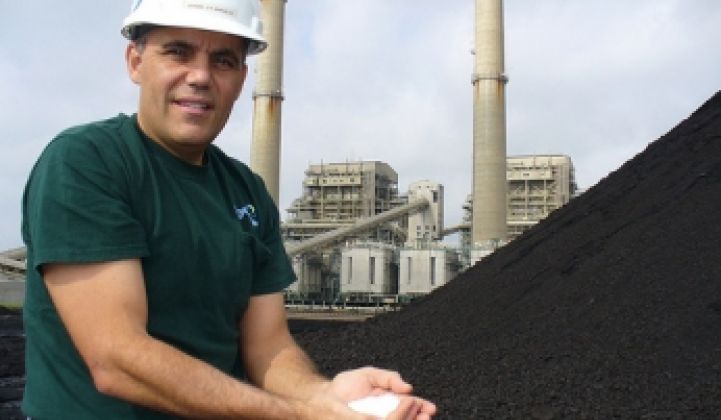How do you cut the cost of carbon capture? Make it about more than just carbon dioxide.
Skyonic, which has developed a system for converting smokestack fumes into sodium bicarbonate (baking soda) and other minerals, is moving toward commercialization and says that early data from its pilot plant indicate that it will be able to undercut many of the industry estimates for the cost of capturing the gas.
"We can capture carbon for less than $22 a metric ton" at scale, said CEO Joe Jones in an interview. The cost figure does not include revenue generated from selling minerals produced in the process.
By contrast, McKinsey & Co. has estimated that early traditional techniques for carbon capture, i.e., storing it in underground caves, will cost $80 to $120 a ton and go down to the $30-to-$60 range over time. Some of the cost can be defrayed by selling pressurized streams of CO2 to oil companies for enhanced oil recovery.
Perhaps an even bigger problem for conventional sequestration lies in convincing the public and policymakers that these geological storage units won't leak.
"They wind up with a Coca-Cola bottling problem," Jones said.
Skyonic recently landed its first patent and next month will begin to shop around a reference design for its SkyMine process to cement producers, utilities and others. A small pilot plant has been running for two years and a large commercial-scale plant capable of converting 75 tons of carbon dioxide a year into bicarbonates is slated to start working in the middle of 2012. (Disclosure: I was recently quoted in a Skyonic press release. We weren't paid for it and the quote essentially was derived from earlier articles on the potential for mineralization in carbon capture.)
The key is that the company's SkyMine system does three jobs. First, it acts as SOx/NOx scrubber, something big polluters already have to install. It scrubs 99.9 percent of the SOx gases, 99 percent of the NOx and 97 percent of the mercury, Jones asserted.
Second, it gets rid of 96 percent of the carbon dioxide that flows through it, thereby capturing carbon. Third, it results in saleable minerals: sodium carbonates, sodium bicarbonates, magnesium carbonates, hydrogen, chlorine and in the future possibly metals like germanium that go up the stack when coal gets burned.
"We can produce chlorine with 35 percent less energy than the U.S. average. We can produce hydrogen, compared to the steam reformation process, at an equivalent cost but with no CO2 footprint," he said. Hydrogen currently gets produced by cracking methane, which consists of one carbon and four hydrogens, with heat and oxygen.
The bicarbonate is cheap too. "We believe we have costs that are below the miners," he said. "When you can get below the costs of pulling it out of the earth, that's pretty good."
In the end, the only materials released to the atmosphere are nitrogen, oxygen and water, and the water can be recycled for industrial operations.
Is this all still a big 'if'? Yes -- both Skyonic and Calera, which also wants to mineralize carbon dioxide, remain in the prototype stage, and converting flue gases into solids does require additional energy, materials and expenses. How these materials and math problems work out will be intently scrutinized. Skyonic's process revolves around mixing sodium hydroxide with flue gases. Calera mixes carbon dioxide with seawater. Some have said that Skyonic's process will likely require harvesting waste to get the energy balance to work out. Top-tier VCs have mostly passed on carbon mineralization to date.
Other companies, such as Biocee, have proposed converting carbon dioxide into liquid fuel, a more marketable and valuable product. That research, however, is at an earlier stage.
Despite the hurdles toward mineralization, interest in the concept is growing. After the company received a $3 million grant to fund the design of a commercial-scale plant from the Department of Energy, inquiries began to come in from Singapore, Europe and elsewhere. Algae biofuel producers have also made inquiries, because feeding algae sodium bicarbonate instead of raw carbon dioxide eliminates many of the plumbing and circulation issues that come with pumping CO2 into algae ponds, he said.
The company will sell equipment to utilities and industrial manufacturers, as well as offer it as a service.
"We are equal-opportunity carbon reduction proliferators," Jones said.
If the process does take off, Skyonic and others will have to deal with the problem of declining mineral prices. But, ideally, by that time, carbon regulations and taxation will be more widespread.
Side note: Skyonic is also probably one of the few companies ever incubated by a guy watching The Discovery Channel with his kids.



